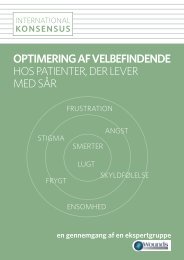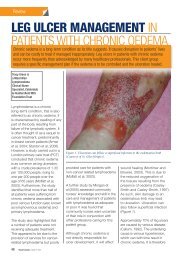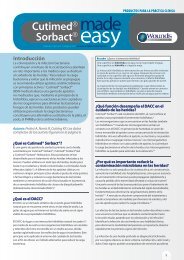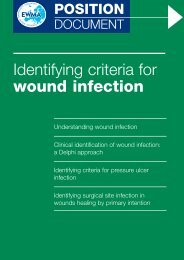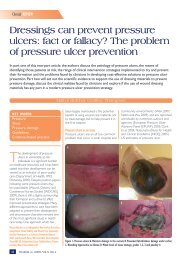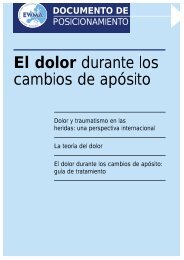best practice guidelines: wound management in diabetic foot ulcers
best practice guidelines: wound management in diabetic foot ulcers
best practice guidelines: wound management in diabetic foot ulcers
- No tags were found...
You also want an ePaper? Increase the reach of your titles
YUMPU automatically turns print PDFs into web optimized ePapers that Google loves.
ASSESSING DFUsBOX 1: Signs of spread<strong>in</strong>g<strong>in</strong>fection (adapted from 49 ) Spread<strong>in</strong>g, <strong>in</strong>tenseerythema Increas<strong>in</strong>g <strong>in</strong>duration Lymphangitis Regional lymphadenitis Hypotension, tachypnoea,tachycardia RigorsFIGURE 6: Necrotic toe whichhas been allowed to autoamputateRISK OF AMPUTATIONArmstrong et al 52 found thatpatients were 11 times morelikely to receive a mid<strong>foot</strong>or higher level amputationif their <strong>wound</strong> had apositive probe-to-bone test.Furthermore, patients with<strong>in</strong>fection and ischaemiawere nearly 90 times morelikely to receive a mid<strong>foot</strong>or higher amputation thanpatients with less advancedDFUs. There may also be apossible correlation betweenlocation of osteomyelitisand major amputation, witha higher rate of transtibialamputation reported whenosteomyelitis <strong>in</strong>volved theheel <strong>in</strong>stead of the mid<strong>foot</strong>or fore<strong>foot</strong> <strong>in</strong> <strong>diabetic</strong>patients 53 .Cultures should not be taken from cl<strong>in</strong>icallynon-<strong>in</strong>fected <strong>wound</strong>s as all <strong>ulcers</strong> will be contam<strong>in</strong>ated;microbiological sampl<strong>in</strong>g cannotdiscrim<strong>in</strong>ate colonisation from <strong>in</strong>fection.Extensive <strong>in</strong>flammation, crepitus, bullae, necrosisor gangrene are signs suggestive of severe<strong>foot</strong> <strong>in</strong>fections 50 . Refer patients immediatelyto an MDFT if you suspect a deep or limbthreaten<strong>in</strong>g<strong>in</strong>fection. Where there is no MDFT,the referral should be to the most appropriatepractitioner, notably the person(s) champion<strong>in</strong>gthe cause of the <strong>diabetic</strong> <strong>foot</strong>, for example anexperienced <strong>foot</strong> surgeon.Refer patients urgently to a member of thespecialist <strong>foot</strong> care team for urgent surgicaltreatment and prompt revascularisation if thereis acute spread<strong>in</strong>g <strong>in</strong>fection (Box 1), critical limbischaemia, wet gangrene or an unexpla<strong>in</strong>ed hot,red, swollen <strong>foot</strong> with or without the presenceof pa<strong>in</strong> 37,51 . These cl<strong>in</strong>ical signs and symptomsare potentially limb- and even life-threaten<strong>in</strong>g.Where necrosis occurs on the distal part of thelimb due to ischaemia and <strong>in</strong> the absence of<strong>in</strong>fection (dry gangrene), mummification of thetoes and auto-amputation may occur. In most ofthese situations, surgery is not recommended.However, if the necrosis is more superficial thenthe toe can be removed with a scalpel (Figure 6).Assess<strong>in</strong>g bone <strong>in</strong>volvementOsteomyelitis may frequently be present <strong>in</strong>patients with moderate to severe <strong>diabetic</strong> <strong>foot</strong><strong>in</strong>fection. If any underly<strong>in</strong>g osteomyelitis is notidentified and treated appropriately, the <strong>wound</strong>is unlikely to heal 17 .Osteomyelitis can be difficult to diagnose <strong>in</strong>the early stages. Wounds that are chronic,large, deep or overlie a bony prom<strong>in</strong>ence areat high risk for underly<strong>in</strong>g bone <strong>in</strong>fection, whilethe presence of a 'sausage toe' or visible boneis suggestive of osteomyelitis. A simple cl<strong>in</strong>icaltest for bone <strong>in</strong>fection is detect<strong>in</strong>g bone by itshard, gritty feel when gently <strong>in</strong>sert<strong>in</strong>g a sterileblunt metal probe <strong>in</strong>to the ulcer 54,55 . This canhelp to diagnose bone <strong>in</strong>fection (when thelikelihood is high) or exclude (when the likelihoodis low) 46 .Pla<strong>in</strong> x-rays can help to confirm the diagnosis,but they have a relatively low sensitivity (early <strong>in</strong>the <strong>in</strong>fection) and specificity (late <strong>in</strong> the courseof <strong>in</strong>fection) for osteomyelitis 46,56 .The National Institute for Health and CareExcellence (NICE) <strong>in</strong> the UK and IDSArecommend that if <strong>in</strong>itial x-rays do not confirmthe presence of osteomyelitis and suspicionrema<strong>in</strong>s high, the next advanced imag<strong>in</strong>g testto consider is magnetic resonance imag<strong>in</strong>g(MRI) 1,46 . If MRI is contra<strong>in</strong>dicated or unavailable,white blood cell scann<strong>in</strong>g comb<strong>in</strong>ed witha radionuclide bone scan may be performed<strong>in</strong>stead 46 . The most def<strong>in</strong>itive way to diagnoseosteomyelitis is by the comb<strong>in</strong>ed f<strong>in</strong>d<strong>in</strong>gs ofculture and histology from a bone specimen.Bone may be obta<strong>in</strong>ed dur<strong>in</strong>g deep debridementor by biopsy 46 .INSPECTING FEET FORDEFORMITIESExcessive or abnormal plantar pressure, result<strong>in</strong>gfrom limited jo<strong>in</strong>t mobility, often comb<strong>in</strong>edwith <strong>foot</strong> deformities, is a common underly<strong>in</strong>gcause of DFUs <strong>in</strong> <strong>in</strong>dividuals with neuropathy 6 .These patients may also develop atypicalwalk<strong>in</strong>g patterns (Figure 7). The result<strong>in</strong>galtered biomechanical load<strong>in</strong>g of the <strong>foot</strong> canresult <strong>in</strong> callus, which <strong>in</strong>creases the abnormalpressure and can cause subcutaneous haemorrhage7 . Because there is commonly loss ofsensation, the patient cont<strong>in</strong>ues to walk on the<strong>foot</strong>, <strong>in</strong>creas<strong>in</strong>g the risk of further problems.Typical presentations result<strong>in</strong>g <strong>in</strong> high plantarpressure areas <strong>in</strong> patients with motor neuropathyare 7 : A high-arch <strong>foot</strong> Clawed lesser toes Visible muscle wast<strong>in</strong>g <strong>in</strong> the plantar archand on the dorsum between the metatarsalshafts (a ‘hollowed-out’ appearance) Gait changes, such as the <strong>foot</strong> ‘slapp<strong>in</strong>g’ onthe ground Hallux valgus, hallux rigidus and fatty paddepletion.In people with diabetes, even m<strong>in</strong>or traumacan precipitate a chronic ulcer 7 . This mightbe caused by wear<strong>in</strong>g poorly fitt<strong>in</strong>g <strong>foot</strong>wearor walk<strong>in</strong>g bare<strong>foot</strong>, or from an acute <strong>in</strong>jury.In some cultures the frequent adoption of theprayer position and/or sitt<strong>in</strong>g cross-legged willcause ulcerations on the lateral malleoli, andto a lesser extent the dorsum of the <strong>foot</strong>, <strong>in</strong>the mid-tarsal area. The dorsal, plantar andposterior surfaces of both feet and betweenthe toes should be checked thoroughly forbreaks <strong>in</strong> the sk<strong>in</strong> or newly established DFUs.BEST PRACTICE GUIDELINES: WOUND MANAGEMENT IN DIABETIC FOOT ULCERS 7




